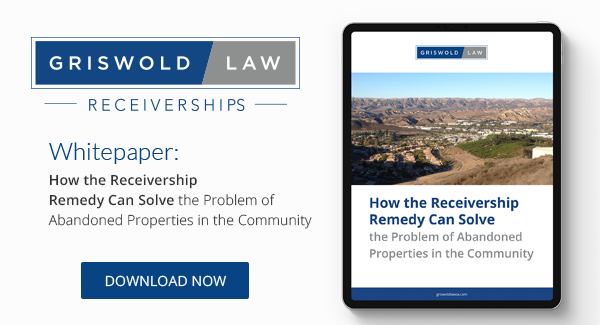The Health & Safety Receivership remedy is available to communities in California that have a goal of eliminating substandard, abandoned, and nuisance properties. More specifically, this receivership solution is utilized when these properties pose a health and safety risk to individuals in the community, or perhaps even the community at large.
California’s Health & Safety Receivership Code
Health & Safety Receiverships are governed by California’s Health and Safety Code § 17980.7 . The statute allows for a receiver to be appointed by a court in specific circumstances, such as when a property owner is negligent or incapable of maintaining the property in a way that is safe for its inhabitants and community.
What Does a Receiver Do?
A receiver, when appointed by the court, takes responsibility for a substandard or blighted property and remediates it.
Although a receiver is nominated by the petitioning party, which is often the city, the receiver serves as a neutral third party, and the receiver’s main responsibility is to fulfill the orders of the court.
A receiver’s objective is to make all of the necessary decisions to rehabilitate the property and make it safe for inhabitants again.
Receivers are responsible for:
-
Placing a lien on the property in order to fund the rehabilitation process
-
Accounting for any money that is spent during the rehabilitation process by providing monthly reports to the court
-
Arranging for property occupants to be safely relocated for the duration of the process
-
Taking into consideration each parties’ perspective but prioritizing the orders of the court
When is a Health & Safety Receivership Necessary?
The four most common causes for a Health & Safety Receivership to be initiated are hoarding, nuisance and drug activity, illegal conversions, and tenant habitability concerns.
Hoarding
Regardless of what causes an individual’s hoarding, this behavior puts individuals, families, and the community at risk. When hoarders accumulate large amounts of possessions and waste, a court-appointed receiver may be needed to safely relocate the property’s inhabitants, obtain specialized clean-up services, and remove hazardous materials such as human and animal waste or even dead animals.
Nuisance and Drug Activity
When a property has been used to manufacture, sell, or use illegal drugs, that property becomes a threat to the community. There is an increased risk of fire, explosions, increased police activity, injury, and death due to illicit drug use. A health and safety receiver secures the property and makes a determination regarding whether or not it can be rehabilitated. If it is salvageable, the receiver oversees the remediation process.
Illegal Conversions
In an attempt to convert single-family homes to fit more residents, some landlords and property owners illegally convert these homes. Overcrowding comes with significant risks in the form of injury, fire, respiratory illness, and more. Receivers assess the problem and restore the single-family home to meet all local codes and ordinances.
Tenant Habitability Concerns
The State of California provides tenants with the right to a safe living environment and an honored lease contract. A landlord who refuses to honor its obligation may be addressed by the courts. A court-appointed receiver evaluates the health and safety risks in the building and develops a plan to align the building with code compliance and health codes.
Health & Safety Receivership Tasks
Some of the tasks that health and safety receivers take on include:
-
Assessing for fire risk, hillside stability, and seismic danger
-
Rectifying unpermitted construction
-
Addressing frequent 911 calls
-
Remedying high crime rates that are a result of non-existent or negligent property management
-
Eliminating abandoned and unsecured structures
-
Moving occupants out of dangerous living conditions
-
Removing junk, debris, and waste
-
Treating properties for hazardous materials, such as asbestos and mold
-
Maintaining exteriors
-
Discovering and responding to structural inadequacies
-
Restoring utilities such as heat, running water, and electricity
Receivership Timeline

The amount of time it takes for a receiver to finish the job is related to the condition of the property, the sophistication of the remediation project, and the cooperation of all involved parties. It is not uncommon for the process to take around 6 months.
However, the process usually follows a predictable order of events.
1. The court appoints the receiver, who has typically been nominated by the city
2. The receiver takes control of the property
3. Tenants or residents are temporarily relocated from the property if necessary
4. The property is rehabilitated
5. The property is either reoccupied or listed for sale.
Learn More About How the Health & Safety Receivership Can Help Your Community
Abandoned, substandard, and nuisance properties are a problem for innumerable communities in California. Residential neighborhoods are burdened with the negative impacts of these distressed properties.
Griswold Law has served as a court-appointed receiver in countless cases in California. We are offering this public information about how to address concerns related to health and safety risks in communities and neighborhoods.
Click here to download our whitepaper: “How the Receivership Remedy Can Solve the Problem of Abandoned Properties in the Community.”


